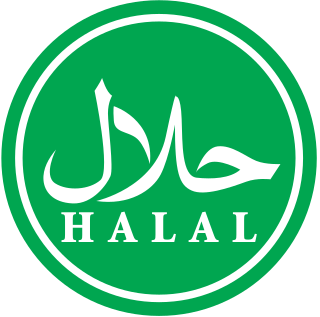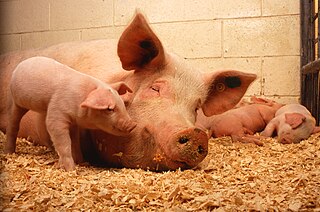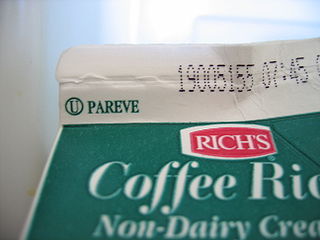| Part of a series on |
| Judaism |
|---|
   |
This is a list of fish that are considered both halal , by Muslims, and kosher, by Jews according to halakha .
| Part of a series on |
| Judaism |
|---|
   |
This is a list of fish that are considered both halal , by Muslims, and kosher, by Jews according to halakha .
| Part of a series on Sunni Islam |
|---|
| Part of a series on Shia Islam |
|---|
 |
| |
In Sunni Islam, there are two general schools of thought. Most Sunni Muslim schools of jurisprudence (Shafi'i, Hanbali, and Maliki) hold as a general rule that all "sea game" (animals of the sea) are permissible to eat with a few minor exceptions. Thus, for example, the local dish Laksa (which includes meats such as shrimp and squid with a soup base made from shrimp paste), is deemed permissible in the Shafi'i Sunni Muslim majority nations of Indonesia and Malaysia where it is commonly consumed.
In the Hanafi school, to which the majority of Sunni Muslims belong, only "fish" (as opposed to all "sea game") are permissible, including eel, croaker and hagfish.
Any other sea (or water) creatures which are not fish, therefore, are also makruh (detestable/abominable, but not strictly forbidden) whether they breathe oxygen from water through gills (such as prawns, lobsters and crabs, which are crustaceans), molluscs such as clams, octopus, mussels and squid, especially if they breathe oxygen from air through lungs (such as sea turtles and sea snakes which are reptiles, dolphins and whales which are mammals, or semi-aquatic animals like penguins which are birds, saltwater crocodiles which are reptiles, seals which are mammals, and frogs which are amphibians). [1]
Under the Ja'fari jurisprudence followed by most Shia Muslims (including most Twelvers and Ismailis, the largest extant Shia sects), only certain fish are considered permissible for consumption. Any fish without scales are haram (forbidden) but fish that do have scales are permissible. [2] Shia scholars tend to teach that no other aquatic creatures are halal, with the exception of certain edible aquatic crustaceans (i.e., shrimps but not crabs), [3] [4] [5] which are also Halal like scaled fish.
The Ja'fari Shia Islam rules are approximately equivalent to kashrut rules. The two are generally the least inclusive:
All fish in this article have true (visible) fish scales, an endoskeleton, fins, and gills (as opposed to lungs). The requirement for gills is not part of any religious rule, but biologically it is an identifying characteristic of true fish. Any animal lacking any of the latter three features is not a fish, and is therefore not valid for this article. [9] : 343
The rules are relaxed in some Islamic schools of thought, both Shia and Sunni. Some have looser definitions which include the exoskeleton of crustaceans as "scales", others yet include the softer exoskeletons of prawns as "scales" but exclude the harder exoskeletons of lobsters. They also differ in the definition of fish, some adopting a loose definition to include all water life ("sea game").
According to the chok or divine decrees of the Torah and the Talmud, for a fish to be declared kosher, it must have scales and fins. [8]
The definition of "scale" differs from the definitions presented in biology, in that the scales of a kosher fish must be visible to the eye, present in the adult form, and can be easily removed from the skin either by hand or scaling knife. [8]
Thus, a grass carp, mirror carp, and salmon are kosher, whereas a shark, whose "scales" are microscopic dermal denticles, a sturgeon, whose scutes can not be easily removed without cutting them out of the body, and a swordfish, which loses all of its scales as an adult, are all not kosher. [8] [10] [11]
When a kosher fish is removed from the water, it is considered "slaughtered", and it is unnecessary to ritually kill it in the manner of kosher livestock. However, kosher law explicitly forbids the consumption of a fish while it is still alive. [8]
Although Joseph Karo of Safed, in his 16th-century legal commentary the Beit Yosef , considers eating milk and fish together to be a health risk, [12] Karo does not mention a prohibition of eating dairy and fish together in the Shulchan Aruch . [13]
Most rabbinic authorities from that time onwards, including almost all Ashkenazi ones, have ruled that this was a scribal error, and there is neither Talmudic basis nor any other rabbinical precedent for prohibiting milk and fish, and thus permit such mixtures. Indeed, two passages in the Babylonian Talmud implicitly state that it is entirely permissible. [14]
Nevertheless, since Karo and other rabbis wrote that milk and fish should not be mixed, there are some Jewish communities whose practice is not to mix them. [15] The Chabad custom is not to eat fish together with actual milk, but to permit it where other dairy products are involved, so that adding a touch of butter or cream to the milk is sufficient to permit mixing it with fish. [16]
This section may require cleanup to meet Wikipedia's quality standards. The specific problem is: might be more clear to list biological names, species or higher taxa.(January 2021) |
Kashrut is a set of dietary laws dealing with the foods that Jewish people are permitted to eat and how those foods must be prepared according to Jewish law. Food that may be consumed is deemed kosher, from the Ashkenazi pronunciation of the term that in Sephardic or Modern Hebrew is pronounced kashér, meaning "fit". Food that may not be consumed, however, is deemed treif, also spelled treyf.

Shellfish is a colloquial and fisheries term for exoskeleton-bearing aquatic invertebrates used as food, including various species of molluscs, crustaceans, and echinoderms. Although most kinds of shellfish are harvested from saltwater environments, some are found in freshwater. In addition, a few species of land crabs are eaten, for example Cardisoma guanhumi in the Caribbean. Shellfish are among the most common food allergens.

Islamic dietary laws are laws that Muslims follow in their diet. Islamic jurisprudence specifies which foods are halal and which are haram. The dietary laws are found in the Quran, the holy book of Islam, as well as in collections of traditions attributed to the Islamic prophet Muhammad.

The swordfish, also known as the broadbill in some countries, are large, highly migratory predatory fish characterized by a long, flat, pointed bill. They are a popular sport fish of the billfish category, though elusive. Swordfish are elongated, round-bodied, and lose all teeth and scales by adulthood. These fish are found widely in tropical and temperate parts of the Atlantic, Pacific, and Indian Oceans, and can typically be found from near the surface to a depth of 550 m (1,800 ft), and exceptionally up to depths of 2,234 m. They commonly reach 3 m (10 ft) in length, and the maximum reported is 4.55 m in length and 650 kg (1,430 lb) in weight.

Roe, or hard roe, is the fully ripe internal egg masses in the ovaries, or the released external egg masses, of fish and certain marine animals such as shrimp, scallop, sea urchins and squid. As a seafood, roe is used both as a cooked ingredient in many dishes, and as a raw ingredient for delicacies such as caviar.

Halal is an Arabic word that translates to 'permissible' in English. In the Quran, the term halal is contrasted with the term haram. This binary opposition was elaborated into a more complex classification known as "the five decisions": mandatory, recommended, neutral, reprehensible and forbidden. Islamic jurists disagree on whether the term halal covers the first two or the first four of these categories. In recent times, Islamic movements seeking to mobilize the masses and authors writing for a popular audience have emphasized the simpler distinction of halal and haram.

In some religions, an unclean animal is an animal whose consumption or handling is taboo. According to these religions, persons who handle such animals may need to ritually purify themselves to get rid of their uncleanliness.
Haram is an Arabic term meaning 'forbidden'. This may refer to either something sacred to which access is not allowed to the people who are not in a state of purity or who are not initiated into the sacred knowledge; or, in direct contrast, to an evil and thus "sinful action that is forbidden to be done". The term also denotes something "set aside", thus being the Arabic equivalent of the Hebrew concept חרם and the concept of sacer in Roman law and religion. In Islamic jurisprudence, haram is used to refer to any act that is forbidden by Allah and is one of the five Islamic commandments that define the morality of human action.
Kosher foods are foods that conform to the Jewish dietary regulations of kashrut. The laws of kashrut apply to food derived from living creatures and kosher foods are restricted to certain types of mammals, birds and fish meeting specific criteria; the flesh of any animals that do not meet these criteria is forbidden by the dietary laws. Furthermore, kosher mammals and birds must be slaughtered according to a process known as shechita and their blood may never be consumed and must be removed from the meat by a process of salting and soaking in water for the meat to be permissible for use. All plant-based products, including fruits, vegetables, grains, herbs and spices, are intrinsically kosher, although certain produce grown in the Land of Israel is subjected to other requirements, such as tithing, before it may be consumed.

Jewish cuisine refers to the worldwide cooking traditions of the Jewish people. During its evolution over the course of many centuries, it has been shaped by Jewish dietary laws (kashrut), Jewish festivals and holidays, and traditions centred around Shabbat. Jewish cuisine is influenced by the economics, agriculture, and culinary traditions of the many countries where Jewish communities have settled and varies widely throughout the entire world.

In kashrut, the dietary laws of Judaism, pareve is a classification of edible substances that contain neither dairy nor meat ingredients. Food in this category includes all items that grow from the ground, fish, eggs, and non-biological edible items.
Some people do not eat various specific foods and beverages in conformity with various religious, cultural, legal or other societal prohibitions. Many of these prohibitions constitute taboos. Many food taboos and other prohibitions forbid the meat of a particular animal, including mammals, rodents, reptiles, amphibians, fish, molluscs, crustaceans and insects, which may relate to a disgust response being more often associated with meats than plant-based foods. Some prohibitions are specific to a particular part or excretion of an animal, while others forgo the consumption of plants or fungi.

Many species of fish are caught by humans and consumed as food in virtually all regions around the world. Fish has been an important dietary source of protein and other nutrients.

Kosher style refers to foods commonly associated with Jewish cuisine but which may or may not actually be kosher. It is a stylistic designation rather than one based on the laws of kashrut. In some U.S. states, the use of this term in advertising is illegal as a misleading term under consumer protection laws.
The Islamic dietary laws (halal) and the Jewish dietary laws are both quite detailed, and contain both points of similarity and discord. Both are the dietary laws and described in distinct religious texts: an explanation of the Islamic code of law found in the Quran and Sunnah and the Jewish code of laws found in the Torah, Talmud and Shulchan Aruch.

Kosher animals are animals that comply with the regulations of kashrut and are considered kosher foods. These dietary laws ultimately derive from various passages in the Torah with various modifications, additions and clarifications added to these rules by halakha. Various other animal-related rules are contained in the 613 commandments.
The mixture of meat and dairy is forbidden according to Jewish law. This dietary law, basic to kashrut, is based on two verses in the Book of Exodus, which forbid "boiling a (goat) kid in its mother's milk" and a third repetition of this prohibition in Deuteronomy.

The harvesting and consuming of seafoods are ancient practices that may date back to at least the Upper Paleolithic period which dates to between 50,000 and 10,000 years ago. Isotopic analysis of the skeletal remains of Tianyuan man, a 40,000-year-old modern human from eastern Asia, has shown that he regularly consumed freshwater fish. Archaeology features such as shell middens, discarded fish bones and cave paintings show that sea foods were important for survival and consumed in significant quantities. During this period, most people lived a hunter-gatherer lifestyle and were, of necessity, constantly on the move. However, where there are early examples of permanent settlements such as those at Lepenski Vir, they are almost always associated with fishing as a major source of food.

Halal conspiracy theories revolve around a series of Islamophobic conspiracy theories and hoaxes regarding halal certification in products such as food, beverages and cosmetics. The claims usually made include that the sale of halal-certified goods in stores is a precursor to the Islamization or institution of Sharia law in a non-Muslim country, that the fees paid by companies for halal certification fund Islamic terrorism, that halal slaughter for meat is cruel, unhygienic or constitutes as animal sacrifice, among others. The spread of these claims has resulted in boycotts and harassment campaigns against businesses who sell halal-certified products, most notably in Australia and India, although anti-halal boycott movements also exist in Denmark, France, Canada, New Zealand, the United Kingdom and the United States.